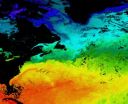(Press-News.org) PASADENA, Calif.—If you're sitting on a bench in New York City's Central Park in winter, you're probably freezing. After all, the average temperature in January is 32 degrees Fahrenheit. But if you were just across the pond in Porto, Portugal, which shares New York's latitude, you'd be much warmer—the average temperature is a balmy 48 degrees Fahrenheit.
Throughout northern Europe, average winter temperatures are at least 10 degrees Fahrenheit warmer than similar latitudes on the northeastern coast of the United States and the eastern coast of Canada. The same phenomenon happens over the Pacific, where winters on the northeastern coast of Asia are colder than in the Pacific Northwest.
Researchers at the California Institute of Technology (Caltech) have now found a mechanism that helps explain these chillier winters—and the culprit is warm water off the eastern coasts of these continents.
"These warm ocean waters off the eastern coast actually make it cold in winter—it's counterintuitive," says Tapio Schneider, the Frank J. Gilloon Professor of Environmental Science and Engineering.
Schneider and Yohai Kaspi, a postdoctoral fellow at Caltech, describe their work in a paper published in the March 31 issue of the journal Nature.
Using computer simulations of the atmosphere, the researchers found that the warm water off an eastern coast will heat the air above it and lead to the formation of atmospheric waves, drawing cold air from the northern polar region. The cold air forms a plume just to the west of the warm water. In the case of the Atlantic Ocean, this means the frigid air ends up right over the northeastern United States and eastern Canada.
For decades, the conventional explanation for the cross-oceanic temperature difference was that the Gulf Stream delivers warm water from the Gulf of Mexico to northern Europe. But in 2002, research showed that ocean currents aren't capable of transporting that much heat, instead contributing only up to 10 percent of the warming.
Kaspi's and Schneider's work reveals a mechanism that helps create a temperature contrast not by warming Europe, but by cooling the eastern United States. Surprisingly, it's the Gulf Stream that causes this cooling.
In the northern hemisphere, the subtropical ocean currents circulate in a clockwise direction, bringing an influx of warm water from low latitudes into the western part of the ocean. These warm waters heat the air above it.
"It's not that the warm Gulf Stream waters substantially heat up Europe," Kaspi says. "But the existence of the Gulf Stream near the U.S. coast is causing the cooling of the northeastern United States."
The researchers' computer model simulates a simplified, ocean-covered Earth with a warm region to mimic the coastal reservoir of warm water in the Gulf Stream. The simulations show that such a warm spot produces so-called Rossby waves.
Generally speaking, Rossby waves are large atmospheric waves—with wavelengths that stretch for more than 1,000 miles. They form when the path of moving air is deflected due to Earth's rotation, a phenomenon known as the Coriolis effect. In a way similar to how gravity is the force that produces water waves on the surface of a pond, the Coriolis force is responsible for Rossby waves.
In the simulations, the warm water produces stationary Rossby waves, in which the peaks and valleys of the waves don't move, but the waves still transfer energy. In the northern hemisphere, the stationary Rossby waves cause air to circulate in a clockwise direction just to the west of the warm region. To the east of the warm region, the air swirls in the counterclockwise direction. These motions draw in cold air from the north, balancing the heating over the warm ocean waters.
To gain insight into the mechanisms that control the atmospheric dynamics, the researchers speed up Earth's rotation in the simulations. In those cases, the plume of cold air gets bigger—which is consistent with it being a stationary Rossby-wave plume. Most other atmospheric features would get smaller if the planet were to spin faster.
Although it's long been known that a heat source could produce Rossby waves, which can then form plumes, this is the first time anyone has shown how the mechanism causes cooling that extends west of the heat source. According to the researchers, the cooling effect could account for 30 to 50 percent of the temperature difference across oceans.
This process also explains why the cold region is just as big for both North America and Asia, despite the continents being so different in topography and size. The Rossby-wave induced cooling depends on heating air over warm ocean water. Since the warm currents along western ocean boundaries in both the Pacific and Atlantic are similar, the resulting cold region to their west would be similar as well.
The next step, Schneider says, is to build simulations that more realistically reflect what happens on Earth. Future simulations would incorporate more complex features like continents and cloud feedbacks.
INFORMATION:
The research described in the Nature paper, "Winter cold of eastern continental boundaries induced by warm ocean waters," was funded by the NOAA Climate and Global Change Postdoctoral Fellowship, administrated by the University Corporation for Atmospheric Research; a David and Lucille Packard Fellowship; and the National Science Foundation.
Warm water causes extra-cold winters in northeastern North America and northeastern Asia
2011-03-31
ELSE PRESS RELEASES FROM THIS DATE:
Special Issues in Military Divorces
2011-03-31
During military operations such as Enduring Freedom and Desert Storm, the United States Armed Services have fought to protect the interests of the nation. While service members offer their lives as a sacrifice to their country, there are other sacrifices that might not be so evident and that relate to a soldier's family.
In 2009, more than 27,000 divorces occurred in which at least one spouse was an active member of the Army, Air Force, Navy or Marine Corps. While this number represents a levelling in military divorce rates, the issue of military divorce presents unique ...
Blood simple circuitry for cyborgs
2011-03-31
Could electronic components made from human blood be the key to creating cyborg interfaces? Circuitry that links human tissues and nerve cells directly to an electronic device, such as a robotic limb or artificial eye might one day be possible thanks to the development of biological components.
Writing in the International Journal of Medical Engineering and Informatics, a team in India describes how a "memristor" can be made using human blood. Memristors were a theoretical electronic component first suggested in 1971 by Berkeley electrical engineer Leon Chua and finally ...
Mucus: Fighting the war against pollutants
2011-03-31
Are our bodies vulnerable to some pollutants whose lack of solubility in water, or "hydrophobicity," has always been thought to protect us from them? New Tel Aviv University research has discovered that this is indeed the case.
Studies by Dr. Michael Gozin of Tel Aviv University's School of Chemistry at the Raymond and Beverly Sackler Faculty of Exact Sciences and Dr. Dan Peer of TAU's Laboratory of Nanomedicine in the Department of Cell Research and Immunology have revealed that mucus — the thick substance lining those internal bodily organs that come into contact with ...
Nevada Reconsiders the Use of Red-Light Cameras
2011-03-31
In 1999, the Nevada legislature passed a law banning the use of cameras to catch traffic violations at intersections. However, North Las Vegas is now pushing to change that law to allow the use of cameras to go after those running red lights. The current legislative bill to make the change has garnered the support of the Nevada Department of Transportation and the Nevada Sheriff's and Chief's Association. However, it is not without opposition.
The Case For and Against Cameras
Red light cameras work by videoing or photographing cars that do not stop for red lights. ...
A new method to localize the epileptic focus in severe epilepsy
2011-03-31
The first two stereo-EEG explorations in Finland were carried out by neurosurgeons of the Epilepsy surgery team in Helsinki University Central Hospital this spring. The method reinforces other examination methods already in use and opens an excellent opportunity in the exploration of the electric activity of both the surface and the deep brain structures during epileptic seizures. The examination also enables exact localization of the functionally important areas of the brain and improves safety of epilepsy surgery at a later stage.
The stereo-EEG examination was developed ...
Case study reports singing lowers patient's blood pressure prior to surgery
2011-03-31
Doctors report that singing reduced the blood pressure of a 76-year-old woman who had experienced severe preoperative hypertension prior to total knee replacement surgery for osteoarthritis (OA). While the patient was unresponsive to aggressive pharmacologic interventions, the woman's blood pressure dropped dramatically when she sang several religious songs. This case-report appears in the April issue of Arthritis Care & Research, a journal published by Wiley-Blackwell on behalf of the American College of Rheumatology (ACR).
Traditional therapy for preoperative hypertension, ...
Next Round in Fight over Entergy Ruling Expected This Year
2011-03-31
When the Texas Supreme Court upheld the ruling in the Entergy case on rehearing in 2009, it was a huge win for property owners to the detriment of injured workers. The failure of the state legislature to pass a law overturning the Entergy decision that same year seemed to signal defeat for those hoping to protect the rights of injured contract workers to fair compensation for their injuries.
However, the fight over third-party liability for workplace injuries in Texas appears to be far from over. With the Workers' Compensation Division up for their sunset review this ...
KIT presents innovations at the 2011 Hannover Messe
2011-03-31
This release is available in German.
Innovations relating to mobility, energy, bionics, and nano- and microtechnologies will be presented by KIT at the 2011 Hannover Messe from April 4 – 8. At its stand (Hall 2, stand C18), KIT will present a hybrid Porsche racing car, developments in battery research, materials and processes for printable electronics, the KIC InnoEnergy for a European energy supply system, and the Energy Solution Center (EnSoC) competence network. Moreover, KIT contributes to other stands and special exhibitions.
KIT main stand, hall 2, (Research ...
'Spincasting' holds promise for creation of nanoparticle thin films
2011-03-31
Researchers from North Carolina State University have investigated the viability of a technique called "spincasting" for creating thin films of nanoparticles on an underlying substrate – an important step in the creation of materials with a variety of uses, from optics to electronics.
Spincasting, which utilizes centrifugal force to distribute a liquid onto a solid substrate, already has a variety of uses. For example, it is used in the electronics industry to deposit organic thin films on silicon wafers to create transistors.
For this study, the researchers first dispersed ...
NHTSA Proposing to Require Back-Up Cameras in All Cars
2011-03-31
A key federal safety agency has proposed a new rule that would require all new vehicles to have back-up cameras by 2014. The National Highway Traffic Safety Administration is seeking to implement a 2007 Act of Congress that directed NHTSA to amend the federal motor vehicle safety standard on rearview mirrors.
The rule change is designed to improve the ability of a driver to detect pedestrians in the area immediately behind his or her vehicle and minimize the likelihood of a vehicle's running over a pedestrian while its driver is backing the vehicle.
The proposed rule ...


